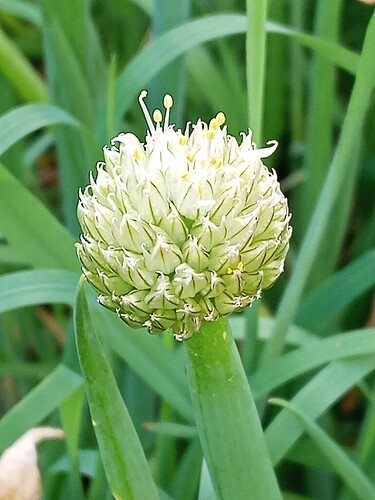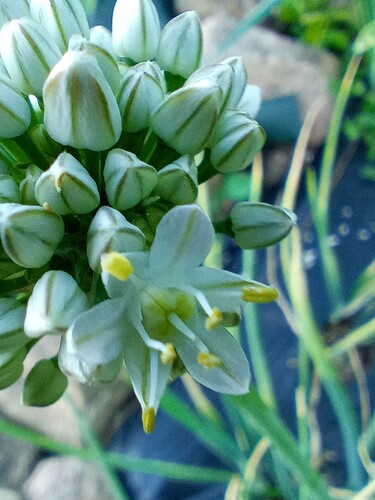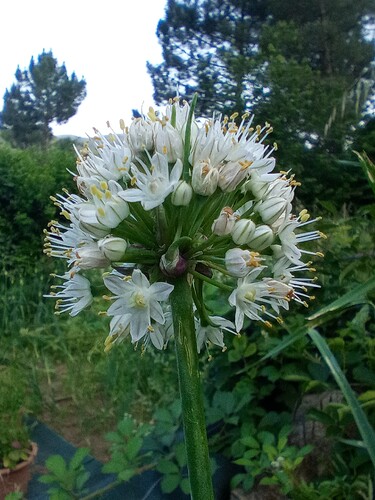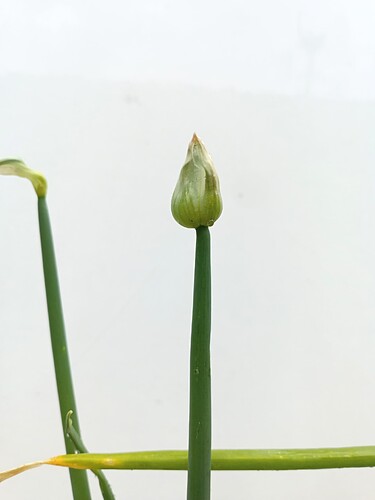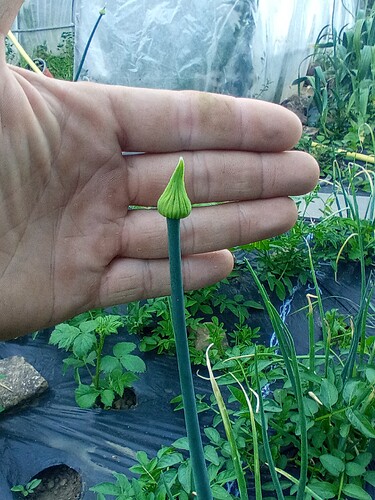Hi Taja. Happy my copy/paste work helped you, but it came from this member, @Joran
This is sooo cool! I never heard of this kind of onion with big bulbs and topsets is it Allium cepa and did you develop the variety?
I grow walking onions but I don’t know much about the crop. Thank you for talking about yours!
Yes, I’m pretty sure it is Allium cepa. I remember seeing similar heirloom varieties in the Seed Savers Exchange back in the 1980’s when I started with them.
What I have now started with a white top setting onion that I got from a local Amish lady after I put an ad in the local newspaper, asking for heirloom varieties people might have. A planted top set produced a single small-medium white onion bulb, when that was planted the next year it would produce a bunch of top sets, and a few flowers. The flowers never had filled seed. Then one year I grew red onion sets, bought at the grocery store, and I got them to bloom at the same time. Now the Amish white top set onion did set seed. When I planted those seeds, there was a diversity of growth habits and bulb colors and sizes. Some just produced seeds, some had top sets and seeds, some just top sets, and some divided at the base like potato onions. None had the perennial “green onion” base like Egyptian onions.
I ended up selecting the yellow top setting onion I pictured earlier, and a nice big red potato onion that I have since lost. I have also lost the original Amish onion.
A few years ago I saw some Red Cippolini onions at the local farmer’s market. On a whim I bought a few and crossed them with my yellow top set. I now have a bunch of new red and yellow top set, and some potato onions to evaluate. Some look promising!
Thanks for sharing the history of this onion and the other fantastic onions you grew. It sounds fun, unique and very worthwhile!! Good luck with your selections.
@ZachDYates, @homesteadculture, I just seen Allium fistulosum here… ![]()
Here are some photos of A. fistulosum:
____________________________________________________
There is at least one trait that seems reliable for their identification: hybrids have ovaries that are green, greenish-yellow, or striped with green:
(Second of the same accession)
Those of Allium cepa are white:
Those of A. fistulosum are green:
On fistulosum you cannot even see the ovary without removing the flower and petals.
The hybrids have more open flowers than A. fistulosum. Similar to those of cepa.
______________________________________________
In the identification of Alliums, the spathes are always very important:
Spathe of hybrids fertile lines without bulbils:
Here, the one of the hybrid with only one or two bulbils (but nevertheless sterile) presented in two different photos above:
Here, from classic A. x proliferum with bulbils:
Here from A. cepa:
And here from A. fistulosum:
… But there’s far too much to say to take the time to write it here and now.
I’ll create a document this winter that I’ll share on GTS.
In the meantime, I’m available for any questions!
Hey @Joran thanks for sharing the detailed photos and identification tips. I’ll definitely be taking a closer look at my onion’s flowers next spring and I’ll try to take some better photos to share. My assumption is that I have the A. cepa x A. fistulosum hybrid because most of the siblings have the walking onion trait with aerial bulbils and in every way look and behave like walking onions. I never grew any A. fistulosums otherwise that could have been mixed up. It will be fun to see for certain next spring when they flower again. And I’ll look forward to seeing your reference guide if you get to it this winter!
Wow, that is really cool, Mike. I’ve never heard of that. Onions are full of possibilities.
Yes, I just sort of fell into it. I have some new “varieties” that I’m trying out. Since many of them produce both top sets (clones) and seeds (crosses), it’s easy to get new ones to try, and keep the ones you like.
@Joran : I am curious, given the shared Allium Family, if these onions aren’t living a parallel life as garlic and TGS? I recall reading a very helpful article on the Garlicana website that briefly got into the discovery purple and marbled purple hardneck types - being most closely related to the earliest ancestors - were the most likely to coax into seed set. Porcelain types also showed decent potential. Within that, there was a higher success rate with those showcasing particular anther color. In this same article, the author mentioned removing bulbils early to essentially coax the plant to shift into flower and consequently seed production. Do the onions work in this same capacity?
Yes, for two reasons:
-
Mechanical: the bulbils develop and compress the flower petioles, causing many to wilt.
-
Nutrient sharing: Allium seeds continue to develop after the plant enters summer dormancy. Consequently, the flower stalk is no longer supplied by the plant. Only the nutrients present in the stalk are needed for seed maturation.
Thus, leaving the bulbils hinders seed maturation by leeching nutrients and water from the flowers stalk.
But, let’s be clear:
The goal here is to optimize seed production for a sexually fertile plant!
(Which, in this case, would be described as a partially fertile plant.)
Because their sexual sterility has mitotic origins; and apart from polyploidization, nothing can be done about it.
Incredible research Joran! Thanks for keep us up to date on your work.


